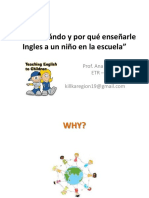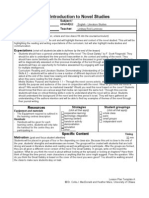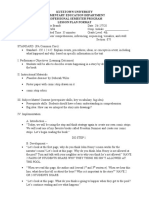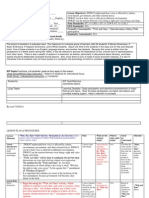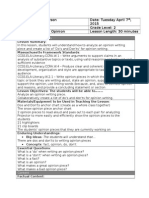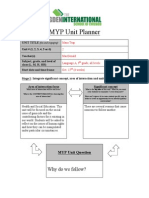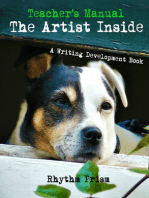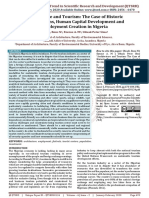Example Lessons
Example Lessons
Uploaded by
api-240103311Copyright:
Available Formats
Example Lessons
Example Lessons
Uploaded by
api-240103311Original Title
Copyright
Available Formats
Share this document
Did you find this document useful?
Is this content inappropriate?
Copyright:
Available Formats
Example Lessons
Example Lessons
Uploaded by
api-240103311Copyright:
Available Formats
Example Lesson 1: Worldview
Context within
Unit Plan:
This is the first lesson within the unit plan. At this point, students have not
begun either The Book Thief or The Diary of a Young Girl. This lesson introduces
the theme of worldview.
It was designed with unit goals 1, 2, & 6 in mind.
Objectives: Students will have a basic understanding of worldview
Definition: your worldview is the framework with which you
view and understand the world.
Worldview is shaped by our beliefs about the world and
experiences that weve had.
Our worldview help us answer basic questions of human
existence.
Everyone has a worldview conscious or unconscious.
Your worldview determines how you act in the world.
Students will struggle to define the Christian response to these basic
questions of human existence, aka a Biblical Worldview.
Students will be able to explain what worldview is.
Students will work together in groups to predict how people will act in
the world.
Materials: Biblical Worldview/ Interviewees Worldview handouts for every student
(See Appendix 4)
Scenarios for every pod (See Appendix 6)
Classroom Setup: Desks will be arranged into pods of students for group work. From their pods,
however, students still need to be able to see the board.
Assessment: Pre-assessment: Students discuss scenarios.
Formative Assessment: Students discussion of Christian worldview.
Summative Assessment: Interviewees Worldview handout homework
Outline:
Group discussion
of scenarios: 10
minutes
Group share:
5 minutes
Explanation of
Worldview:
5 minutes
Group
discussion:
10 minutes
Explanation of
Metaphysical
questions:
5 minutes
Class discussion:
10 minutes
Tell students that they will be working with their desk pods on some
scenarios. Have students read scenarios and discuss questions in their
table groups.
Ask groups to share what they answered.
All these people in the scenarios had different worldviews. A worldview
is the framework with which you view and understand the world. It
works like a lens with a tint. Every person sees the world with a different
tint. Write this definition on the board. Our worldviews are defined by
our beliefs and experiences. Everyone has a worldview, whether
conscious or unconscious.
Have students discuss ways that their beliefs and experiences shape the
way they see the world
Throughout the ages, there have been questions that humans have been
seeking the answers to. Who am I? Why am I here? Where do I come
from? Where am I going? Write the four metaphysical questions on the
board and further explain what they are asking. Distribute Biblical
Worldview/ Interviewees Worldview handouts. Ask students,
Philosophers have tried their hand at answering these questions and
religions have answered these questions in different ways. The answers
to these questions help define our worldview What would a Christians
answer to these questions look like? How does the Bible speak to these
questions?
Have students volunteer what they think the biblical answers to these
questions would be. Guide students.
Explain to students that the books that they will be reading in the next
unit will help them explore the concept of worldview.
Homework: Interview: Have students interview someone they know who they would
guess has a pretty different worldview than their own asking the
interviewee the metaphysical questions.
Reading
Reading Journal 1.
Accommodations: Aaron: This lesson involves a lot of group discussion which may be difficult
so I need to be aware of how Aarons pod is doing.
Talia: Should need no accommodations for this lesson.
Example Lesson 2: Symbolic Representation Interview
Context within
Unit Plan:
This lesson occurs after finishing Part 1 of The Book Thief.
The idea for a SRI came from Wilhelm pp. 64-65
It was designed with unit goals 6 & 7 in mind.
Objectives: Students will retell what they have read in The Book Thief using their
own created symbols.
Students will fill in gaps in their understanding and establish a solid base
of the story on which they can build as they continue reading.
Materials: Craft materials: scissors, glue, markers, colored pencils, ribbon, tape, etc.
Classroom Setup: Students work in groups of three.
Assessment: Pre-assessment: Watch students create symbols and tell stories.
Formative Assessment: N/A
Summative Assessment: Students journals
Outline:
Explain SRI to
students:
2 minutes
Allow students to
create:
13 minutes
Students retell
story: 30 minutes
1. Today you will be retelling the first art of The Book Thief in your table
pods. You will begin by using the craft materials to construct whatever
symbols you need to tell your story. Go over the types of craft materials
are there. Dont think you necessarily have to draw the characters. You
can create something that you want to represent them if youd like. I am
going to give you a minute to think about what you want to create before
I set you loose.Wait a minute. Avoid giving too much detailif you over
outline what to do students may not be as creative.
2. Set students free to create. Make sure that you give students time
warnings so that they can begin telling their stories promptly.
3. Have students begin retelling the story. Each child gives 10 minutes.
Alert students to when the 5 minutes are done and then 10.
Homework: Reading
Reading Journal 3
Accommodations: Aaron: Aaron may find it difficult to listen to others without interrupting.
Talia: This should be fine for Talia. There are parts with anti-Semitism in part
1, on page 51 for example, but since the retelling is in small groups this should be
low stress.
Example Lesson 3: WWII Propaganda and Todays Advertisements
Context within
Unit Plan:
Since students are studying Marcus Zusaks The Book Thief and The Diary of a
Young Girl, WWII propaganda is particularly appropriate as both the Axis and the
Allies used it to promote their worldview. Students explore the ideas of
worldview and perspective through propaganda.
One of the propaganda pieces, Kultur-Terror, was chosen not only because it
demonstrates a Nazi perspective on American but because it is also a helpful way
for students to begin thinking about Americas role in the war. (This pieces leads
well into lesson on Bob Dylan and the Bible on Justice.)
The other piece We Can Do It was selected because it is likely that students
have seen it before and may know something about its origins. In this way,
students preexisting knowledge is activated and they are better able to scaffold
new material. The lesson plan was designed with a variety of students in mind as
it involves classroom discussion, group work, and individual work.
I hope that by studying the propaganda which played an important role in
WWII students will realize that propaganda and similar media, for example, ads
in magazines and TV commercials, are tools wielded by humans with agendas.
Ads and commercials appeal to the viewers needs and can stir thought or spur
action from the viewer.
I hope that this lesson causes students to consider deep, essential questions
(though they may not be directly addressed), such as, Can media be morally
neutral? and Does everything that we create reflect our worldview? and God
created the worldis His media neutral or does it bear the fingerprints of its
Potter? The disequilibrium that students may feel with these difficult questions
will be capitalized on in later lessons.
This lesson was designed with unit goals 4 & 6 in mind.
Objectives: -Students will be able to define what propaganda is.
-Students will be able to apply what they have learned from WWII propaganda to
advertisements in their own world.
-Students will be able to examine propaganda and decide which human need is
appealed to (using Maslows hierarchy of needs.)
-Students will consider the larger question: Does everything that we create
reflect our worldview?
Materials: Projector
PowerPoint of selected propaganda and commercials
Propaganda from WWII:
We Can Do It by J. Howard Miller (Rosie the Riveter)
Kultur-Terror by Harald Damsleth
Commercials:
Coke Keeps You Thin (1961 commercial)
Other pictures:
Joseph Goebbels
Nazi book-burning
Coke Commercial and Magazine Ad handouts. (See Appendix 2)
Magazine ads (enough for everyone in the class)
Classroom Setup: Students desks will be moved into pods during group discussion. If this is not
an option, have students move their chairs into groups.
Assessment: Pre-assessment: Asking students what they know about Rosie the Riveter and
propaganda.
Formative assessment: Walking around and monitoring group conversation
and examining turned-in handouts.
Summative assessment: Homework
Outline:
We Can Do It
Hook: 5 minutes
Defining
Propaganda and
the
Role of
propaganda in
the WWII: 10
minutes
Kultur-Terror:
5 minutes
1. Show slide with We Can Do It (Rosie the Riveter). Raise your hand if
you have seen this poster before. Students will raise their hands.
2. What do you know about this poster? Students will raise their hands
and answer. See if students know of this posters connection to World
War II.
3. This poster was a piece of American propaganda during World War II
and was created to inspire women to get involved on the home front.
Propaganda. Lets define propaganda. Does anyone have any idea what
propaganda is? Write propaganda on the board. Students attempt to
define propaganda. Listen, but do not record answers.
4. Heres the definition that well use in this class. Write the definition of
propaganda on the board, a form of communication used to sway
popular thought toward some perspective. Propaganda can be posters,
films, speeches, etc. What perspective does the Rosie the Riveter poster
convey? Students will raise their hands and answer. Students may say
that she represents an American perspective or the belief that women
should join the war effort.
5. What features of this poster make it an effective use of propaganda?
Students will raise their hands and answer. Students should be saying
things like, Rosie looks fierce and muscular with her fist raised and her
raised eyebrows. or The colors and font that are used in the poster are
very bold and dark.
6. Propaganda was used by all the members of the Axis and the Allies
during WWII, but today you will only be looking at a few pieces, German
and American propaganda. Hitler particularly recognized the importance
of propaganda and Joseph Goebbels was appointed the Minister of
Propaganda. It was Joseph Goebbels who called for Germans to burn
books. Show a picture of Joseph Goebbels and a book-burning in
Germany. You should remember a book-burning in one of the books
youve been reading.
7. Show the next slide of the Nazi propaganda, Kultur-Terror. Ask
students,
8. Who do you think created this propaganda? Why?
9. What is the feeling you get looking at this piece of propaganda?
10. What do you think this propaganda promotes? Why?
11. Propaganda affects popular thought by appealing to human desires. The
Rosie the Riveter poster appealed to women because it showed a strong
woman who had an impact on her country. Women in America didnt
have the right to vote and were not considered equal to men, but many of
them wanted this right and equality. This poster appealed to their longing
for equality.
12. Show slide of Maslows Hierarchy of Human Needs. During WWII, a
psychologist named Abraham Maslow created a theory which described
human motivation-- what makes humans do what they do? He believed
that there was a hierarchy of human needs. Read through the different
levels of needs and explain.
13. Different propaganda, all art for that matter, makes appeals to different
human desires. What level of need do you think the Rosie the Riveter
Coke Ad: 12
minutes
Magazine ad: 10
minutes
Journal: 3
minutes
poster appealed to? Why? Students should pick either the level of Self-
actualization or Esteem because women longed to be seen as equals and
be esteemed in American society.
14. When the Nazis created the second poster, Kultur-Terror what human
need do you think they were appealing to? Discuss with the person sitting
next to you. Walk around and listen to students explain for a couple of
minutes. Then return to the front of the classroom.
15. Divide students into groups of three and hand-out the Coke Commercial
and Magazine Ad handout. TV commercials and ads in magazines also
appeal to a basic need and promote a certain lifestyle. I am going to show
you a Coke ad from the 60s and I want you to discuss the ad in your
group and fill-out the hand-out that Ive provided. Show students the
coke ad and have them discuss in groups what level of need they think the
ad appeals to. While they discuss walk around to make sure each student
is filling out their worksheet and guide students where they are getting off
track.
16. Once they finish discussing the Coke ad, hand them a magazine ad and
have them respond to the questions on the back of the handout in
reference to the ad.
17. For the last three minutes, journal about the following question, What
role do you believe worldview has in propaganda? Can you create any
form of communication that isnt affected by your worldview? Students
journal.
Homework: Advertisement/Commercial Analysis:
For homework have students take an advertisement or commercial they see
and write a paragraph in response to each of these three questions to be handed in
the next class:
1. What is the purpose of this ad? Is this ad effective? Why or why not?
2. Which of Maslows basic needs does this ad appeal to? Why?
3. In your own words explain what propaganda is and whether or not you
think your ad is propaganda.
Reading
Reading Journal 5
Accommodations: Aaron: I think this lesson would be good for him because students with
Aspergers often respond well to visual stimuli and, while there is group work,
the social-interactions should be low stress since students compose their own
responses rather than a collective group response.
Talia: The Nazi propaganda, Kultur-Terror, which ridicules Americans, has
a small star of David on it. I purposefully chose this piece of propaganda over
other pieces which had more overt anti-Semitic themes in them in order to be
sensitive to Talia. Kultur-Terror does accurately touch on the anti-Semitic
themes prevalent in Nazi propaganda, but uses the theme for its larger of agenda
of casting Americans in a horrific light.
Example Lesson 4: Bob Dylan and the Bible on Justice
Context within
Unit Plan:
This lesson occurs later in the unit. Through this unit, students explore
worldviews of justice and essential questions such as What does Justice look
like? Can non-Christians show Justice? Is Justice always served? may be
touched on.
I chose the Bob Dylan song for two reasons: first, the song discusses what it
feels like to live in a time where the popular perspective is evolving, and second,
the song demonstrates that the US fought in WWII while having justice issues on
the home front.
I chose the Leviticus passage and the Luke passage because I wanted both an
Old Testament passage and a New Testament passage that discuss elements of
justice. I hope that reading these verses, answering questions on the sheet, and
discussing question 9 will encourage students to ask themselves, What is a
biblical understanding of justice? How can I show justice to my neighbor? I
especially like the Luke passage because Jesus asks his followers to help those
who cant return the favor. I think that the golden rule is often taught to children
as treat others the way they would want to be treated so that you will be treated
the same way. Reciprocity is key. But Christ invites us to a meal that we cant
possibly pay for, and his followers ought to do the same. This distinction is not
the key feature of the lesson but is nevertheless important to me.
This lesson was designed with unit goals 2 & 6 in mind.
Objectives: Students will consider what the Bible says about justice.
Students will discuss The Times They Are A-Changin and note ways
that Bob Dylan shows the changing understanding of justice.
Students will look for examples of justice in The Diary of a Young and
The Book Thief.
Students will look for imagery in The Times They are A-Changin.
Materials: Computer with speakers to play The Times They Are A-Changin and
to display the lyrics. (This avoids copyright issues. See lyrics in
Appendix 1)
Print-out of Kultur-Terror (See Appendix 3) by Harald Damslath for
ELMO
Projector/ELMO for lyrics/print-outs
The Bible and Bob Dylan on Justice worksheets for every student. (See
Appendix 5.)
Drawing utensils
Drawing paper
Classroom Setup: Students will be sitting in a circle of chairs and then will break into smaller
pods.
Students need to bring their Bibles to class
Assessment: Pre-assessment: Students discuss The Times They are A-Changin and draw
imagery from the text.
Formative Assessment: Students share their opinions on Kultur-Terror for a
second time and fill out The Bible and Bob Dylan on Justice worksheets.
Summative Assessment: Students reflect on Maya Angelou quotes in their
journals.
Outline:
Discussion on
Bob Dylan song:
20 minutes
Discussion of
Kultur-Terror: 5
minutes
The Bible and
Bob Dylan on
Justice
Worksheet:15
minutes
Discuss answers
to #9 on
worksheet.
1. Tell students to grab a hard surface to write on and find a seat in the
large circle of chairs. First thing we will do is listen to this song. The
first time we will just listen. The second time I want you to draw a picture
of an image that comes to mind when you listen to this songit shouldnt
be hard since the song has a lot of descriptive imagery in it.
2. Play the song twice. Walk around to make sure students are following
instructions.
3. Have some students volunteer to share what they drew and why they drew
that image.
4. Put lyrics up on projector for students to see. What do you think the
musicians purpose was when he composed this song? What do you see
in the lyrics that support your idea? In other words, what did he want his
audience to learn and how did he teach them?
5. Students share ideas. Guide the conversation. You are particularly
looking for themes of justice, change, reversal of old order. After what
needs to be said is shared, ask students if they know anything about the
origins of this song. Who wrote it? When it was written? The
conversation may naturally shift this way.
6. Sum up conversation. Bob Dylan, an American folk singer, wrote this
song in 1963 during the Civil Rights era. During this time, the Civil
Rights movement and the folk music movement were closely aligned.
The African American Civil Rights movement in the United States really
took off in 1955, after WWII. Those fighting for civil rights were hoping
to end racial segregation and discrimination and establish voting rights
for all people. One of the most interesting facets of the civil rights
movement was that they accomplished their goals in non-violent protests
and civil disobedience, boycotting stores and buses and marching and
singing in the streets. You know some of the leaders of this movement
already, I am sure: Martin Luther King, Rosa Parks Malcolm X. Dylan
wrote this song to put word to the feelings that many were experiencing
during this time: change, justice, freedom, uncertainty about the future,
rebellion, and hope.
7. Show picture of Kultur-Terror again. Remember this propaganda was
made only a few years before the Civil Rights Movement took off. Was
any part of this depiction of America accurate? What do you think?
Students discuss. Many people back then and today say that America is a
stronghold of justicedo you think Dylan agrees?
8. Divide students into small group and ask them to take out their Bibles.
Handout The Bible and Bob Dylan on Justice worksheets and read
directions with students. Students answer questions as a group. Put the
Bob Dylan lyrics up for the students to reference as they answer
questions and walk around to check that students are progressing well.
9. To close class, discuss ways that students have experienced helping those
who cannot repay them.
10. Collect worksheets.
Homework: Reading
Reading Journal 11
Accommodations: Aaron: Aaron may need help coming up with ideas for what to draw during the
song and may need help deciphering metaphoric language.
Talia: As mentioned in previous lessons, Kultur-Terror has a small star of
David in it. This could make Talia uncomfortable.
You might also like
- PieceOfMyHeartDocument22 pagesPieceOfMyHeartmaifathy75% (4)
- Big Questions for Young Minds: Extending Children's ThinkingFrom EverandBig Questions for Young Minds: Extending Children's ThinkingNo ratings yet
- Mini Unit Plan Lesson 2Document7 pagesMini Unit Plan Lesson 2api-4007489840% (1)
- HSC Modern History 2022 Exam PaperDocument24 pagesHSC Modern History 2022 Exam PaperAlexzondra TamiNo ratings yet
- Como Cuando Porque1Document20 pagesComo Cuando Porque1valeriatics VnNo ratings yet
- Differentiated LessonDocument3 pagesDifferentiated Lessonlindsay_115No ratings yet
- Ambush! RulesDocument40 pagesAmbush! RulesJackSiedschlag83% (6)
- Moles Hill Read AloudDocument5 pagesMoles Hill Read Aloudapi-373647228No ratings yet
- 2a, 3 22-3 27Document4 pages2a, 3 22-3 27api-284066194No ratings yet
- MulticulturallessonplanDocument3 pagesMulticulturallessonplanapi-356631921No ratings yet
- Lesson Plan Template EDIS 5400: English EducationDocument9 pagesLesson Plan Template EDIS 5400: English Educationapi-340887844No ratings yet
- The Outsiders Novel UnitDocument33 pagesThe Outsiders Novel Unitsgavan50% (4)
- Kutztown University Elementary Education Department Professional Semester Program Lesson Plan FormatDocument3 pagesKutztown University Elementary Education Department Professional Semester Program Lesson Plan Formatapi-509227540No ratings yet
- Final Mini-Lesson UnitDocument34 pagesFinal Mini-Lesson Unitapi-242273696No ratings yet
- Lesson Plan 7 Books CoverDocument4 pagesLesson Plan 7 Books Coverapi-285008589No ratings yet
- Dyslexia - For Dyslexic Students I Would Allow Them To Record Their QuestionsDocument4 pagesDyslexia - For Dyslexic Students I Would Allow Them To Record Their Questionsapi-298255066No ratings yet
- Making Thinking VisibleDocument4 pagesMaking Thinking VisibledreamthinkdoNo ratings yet
- 3 Fahrenheit 451 Lesson PlanDocument4 pages3 Fahrenheit 451 Lesson Planakravetz2No ratings yet
- Strat Chat 2Document4 pagesStrat Chat 2api-77802920No ratings yet
- Read Aloud Lesson Plan Kindergarten AutorecoveredDocument6 pagesRead Aloud Lesson Plan Kindergarten Autorecoveredapi-455234421No ratings yet
- Grade: 10 Subject: ELA Unit: Merchant of Venice - Consequences of Greed and Selflessness - 3 Lesson Duration: 73 Min. Date: FridayDocument3 pagesGrade: 10 Subject: ELA Unit: Merchant of Venice - Consequences of Greed and Selflessness - 3 Lesson Duration: 73 Min. Date: Fridayapi-484940441No ratings yet
- Daily Lesson Plan: Bell Ringer: How Has Your Family Influenced Your Life? in What Ways Do You Take After Them?Document4 pagesDaily Lesson Plan: Bell Ringer: How Has Your Family Influenced Your Life? in What Ways Do You Take After Them?Anonymous NL82IMVNo ratings yet
- Making Thinking VisibleDocument5 pagesMaking Thinking Visiblewaqarali78692No ratings yet
- Indiana Wesleyan University Elementary Education Lesson Plan Template Reading, Writing, and Oral Language 2007 ACEI StandardsDocument3 pagesIndiana Wesleyan University Elementary Education Lesson Plan Template Reading, Writing, and Oral Language 2007 ACEI Standardsapi-341625144No ratings yet
- Read Aloud FinalDocument3 pagesRead Aloud Finalapi-436591204No ratings yet
- Edu 200 Flipped Classroom Lesson Plan TemplateDocument3 pagesEdu 200 Flipped Classroom Lesson Plan Templateapi-385656611No ratings yet
- WilsonlessonplansDocument13 pagesWilsonlessonplansapi-284963189No ratings yet
- Roanoke-The Lost Colony Lesson PlanDocument5 pagesRoanoke-The Lost Colony Lesson Planapi-300347529No ratings yet
- Cfe 1 - HistoryDocument8 pagesCfe 1 - Historyapi-302761689No ratings yet
- What Is Cognitive Learning Theory and How Do I Use ItDocument18 pagesWhat Is Cognitive Learning Theory and How Do I Use ItRheya Em DiNo ratings yet
- 2 1 Task MaterialDocument18 pages2 1 Task MaterialJESUSERICKNo ratings yet
- Block PlanDocument8 pagesBlock Planapi-301276886No ratings yet
- Powerful Social Studies Lesson Plan Outline JMU Elementary Education Program: ELED 434 ALL SECTIONSDocument14 pagesPowerful Social Studies Lesson Plan Outline JMU Elementary Education Program: ELED 434 ALL SECTIONSapi-242073541No ratings yet
- Lesson 4Document8 pagesLesson 4api-279288252No ratings yet
- Students Will Discover Truth by Challenging Lies Across Content AreasDocument7 pagesStudents Will Discover Truth by Challenging Lies Across Content Areasapi-435628294No ratings yet
- Lesson PlanDocument23 pagesLesson Planapi-273917928No ratings yet
- Inquiry Social Studies LessonDocument9 pagesInquiry Social Studies Lessonapi-365745277No ratings yet
- Who Am I Lesson PlanDocument8 pagesWho Am I Lesson PlanMaryAnnAnabeNo ratings yet
- Extra LessonDocument5 pagesExtra Lessonapi-437591352No ratings yet
- Essential Question:: Ccss - Ela-Literacy.W.8.3.ADocument3 pagesEssential Question:: Ccss - Ela-Literacy.W.8.3.Aapi-284288852No ratings yet
- Cultural Diversity: StereotypesDocument3 pagesCultural Diversity: Stereotypespeg91793No ratings yet
- Ice BreakersDocument25 pagesIce BreakersEmese BodaNo ratings yet
- Stepp Lesson PlanDocument6 pagesStepp Lesson Planapi-257714008No ratings yet
- Read-Aloud Lesson 2Document3 pagesRead-Aloud Lesson 2api-437989808No ratings yet
- Lesson 7 - Our World - Science - Waste Our WorldDocument4 pagesLesson 7 - Our World - Science - Waste Our Worldapi-277527531No ratings yet
- Week 2-4Document2 pagesWeek 2-4api-248112519No ratings yet
- Jamies Ubd Lesson Plan No 2Document3 pagesJamies Ubd Lesson Plan No 2api-301683382No ratings yet
- Lesson Plan #1 1. Descriptive DataDocument16 pagesLesson Plan #1 1. Descriptive Dataapi-220232621No ratings yet
- 11 8 Lesson Plan MejiaDocument4 pages11 8 Lesson Plan Mejiaapi-509628630No ratings yet
- Teacher Education Lesson Plan Template: (Indicator: 3.RL.4)Document3 pagesTeacher Education Lesson Plan Template: (Indicator: 3.RL.4)api-176512276No ratings yet
- Small-Group Inquiry Model For Inquiry Project Stage Teacher Role Student Role ImmerseDocument6 pagesSmall-Group Inquiry Model For Inquiry Project Stage Teacher Role Student Role ImmersebronkscottemaNo ratings yet
- Lesson Idea/Topic and Rational/Relevanc E: What Are You: CEP Lesson Plan FormDocument8 pagesLesson Idea/Topic and Rational/Relevanc E: What Are You: CEP Lesson Plan Formapi-353478397No ratings yet
- Lesson Plan Draft 2Document5 pagesLesson Plan Draft 2api-380745923No ratings yet
- Read 436-Qri Lesson PlansDocument12 pagesRead 436-Qri Lesson Plansapi-251375394No ratings yet
- Ss LP 2Document9 pagesSs LP 2api-386067949No ratings yet
- Fact vs. Opinion WritingDocument4 pagesFact vs. Opinion WritingBrittanyNo ratings yet
- Social Studies Strategies 1Document9 pagesSocial Studies Strategies 1Fernandez RomeldaNo ratings yet
- A Unit-Long Project For Fourth Grade StudentsDocument5 pagesA Unit-Long Project For Fourth Grade Studentsapi-158420314No ratings yet
- Wrong Lunch 2Document3 pagesWrong Lunch 2api-335446378No ratings yet
- Maus Unit Plan PDFDocument5 pagesMaus Unit Plan PDFcollin_macdonal6612No ratings yet
- PLP LogDocument2 pagesPLP Logapi-295229243No ratings yet
- Boone Ted509 ReadingDocument5 pagesBoone Ted509 Readingapi-401961899No ratings yet
- RubricDocument1 pageRubricapi-240103311No ratings yet
- Gaining Through Campaigning Lesson 1Document3 pagesGaining Through Campaigning Lesson 1api-240103311No ratings yet
- Lesson4laartscrossover Doc 1Document7 pagesLesson4laartscrossover Doc 1api-240103311No ratings yet
- Lesson 6 DebateDocument3 pagesLesson 6 Debateapi-240103311No ratings yet
- Human Characteristics Lesson PlanDocument3 pagesHuman Characteristics Lesson Planapi-240103311No ratings yet
- Relative Location I Am PaperDocument2 pagesRelative Location I Am Paperapi-240103311No ratings yet
- Time and What Must Be Done PT 41Document9 pagesTime and What Must Be Done PT 41nujahm1639No ratings yet
- Flames of War - German Brandenburger KompanieDocument2 pagesFlames of War - German Brandenburger Kompaniebtsweston9365No ratings yet
- WL Midterm ReviewerDocument25 pagesWL Midterm Reviewercharles babasaNo ratings yet
- Redzone Podcast Episode #89: Stop Playing To Lose Play To Win: High Performance Leadership Tactics From The 50 Billion Dollar Man - With Dan PeñaDocument24 pagesRedzone Podcast Episode #89: Stop Playing To Lose Play To Win: High Performance Leadership Tactics From The 50 Billion Dollar Man - With Dan Peñalmao lmaoNo ratings yet
- The .50BMG Rifle CalibreDocument9 pagesThe .50BMG Rifle CalibreІгор ШтайєрNo ratings yet
- Aeronautics and AstronauticsDocument256 pagesAeronautics and Astronauticsavialogs100% (1)
- 米機本邦空襲関係資料Document130 pages米機本邦空襲関係資料JapanAirRaids100% (1)
- 15 Jun 2Document9 pages15 Jun 2Mohammad Ismail100% (1)
- WWI MANIA OrganizerDocument2 pagesWWI MANIA OrganizermeenaNo ratings yet
- Infernum - Book of The ConquerorDocument258 pagesInfernum - Book of The ConquerorИлья Рысенков100% (5)
- Ranger School OPORD FormatDocument5 pagesRanger School OPORD Formatfrozzie 108100% (1)
- SA-4B GanefDocument49 pagesSA-4B GanefTamas VarhegyiNo ratings yet
- Signal Intelligence (Sigint) : A Technology Abstract and Proposal For Practical ApplicationDocument11 pagesSignal Intelligence (Sigint) : A Technology Abstract and Proposal For Practical Applicationbezasami100% (1)
- Rogue Space Rules Sample v1.1Document1 pageRogue Space Rules Sample v1.1puntocom111No ratings yet
- Descendants - Of.the - Sun.e15.160413.720p 540p 450p XViD WITH IPOP BarosG LIMO CHAOSrel (Viki Version)Document50 pagesDescendants - Of.the - Sun.e15.160413.720p 540p 450p XViD WITH IPOP BarosG LIMO CHAOSrel (Viki Version)MEILINDANo ratings yet
- 42rkjz88v Lit 1 Contemp - World 1Document97 pages42rkjz88v Lit 1 Contemp - World 1Jesica BalanNo ratings yet
- (Star Wars - Adventure Journal 5) Jackson, Patricia A - A Bitter WinterDocument16 pages(Star Wars - Adventure Journal 5) Jackson, Patricia A - A Bitter WinterlukagrinoNo ratings yet
- "Arrows, Arrows, Everywhere!" Technological Advantages of The Seljuq ArmiesDocument6 pages"Arrows, Arrows, Everywhere!" Technological Advantages of The Seljuq ArmiesadnanNo ratings yet
- Bugh, G.R. - The Theseia in Late Tic AthensDocument19 pagesBugh, G.R. - The Theseia in Late Tic AthensAntigonos80No ratings yet
- Strategic EffectDocument367 pagesStrategic EffectRafael Dobrzeniecki100% (1)
- The Decline and Fall of Pax Americana, by DesertDocument200 pagesThe Decline and Fall of Pax Americana, by DesertDHOBO0% (1)
- British Council HistoryDocument2 pagesBritish Council HistoryJay AlexanderNo ratings yet
- Battle of Blenheim 1704 AnimationDocument7 pagesBattle of Blenheim 1704 AnimationJoey OrtegaNo ratings yet
- Architecture and Tourism The Case of Historic Preservations, Human Capital Development and Employment Creation in NigeriaDocument15 pagesArchitecture and Tourism The Case of Historic Preservations, Human Capital Development and Employment Creation in NigeriaEditor IJTSRDNo ratings yet
- Hobbes State of Nature and The Nature ofDocument10 pagesHobbes State of Nature and The Nature ofPrabhat KumarNo ratings yet
- Bài tâp bổ trợ Tiếng Anh 4 Global Success sách mới Unit 1Document13 pagesBài tâp bổ trợ Tiếng Anh 4 Global Success sách mới Unit 1yuuchan459No ratings yet
- AgamemnonDocument2 pagesAgamemnonAli Raza ShahNo ratings yet




